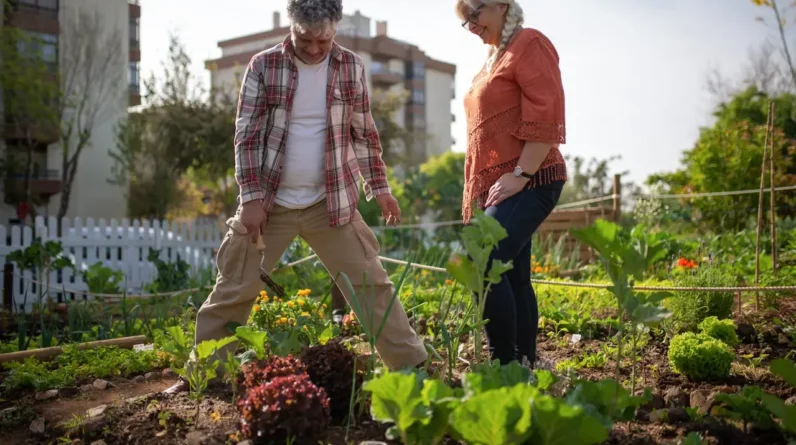
About one in four adults reports feeling lonely.
And loneliness can lead to some pretty adverse mental health effects, such as the development of depression. As we move more online than ever before, this probably doesn’t come as a surprise.
In fact, many people interact more online than they do in person.
However, intentional communities offer an alternative way of living.
These communities prioritize human connection and shared purpose, which involve a conscious effort to create stronger social bonds and more sustainable lifestyles.
So, what is an intentional community anyway?
Intentional communities are groups of people who choose to live together or near each other for a common purpose, sharing resources, responsibilities, and often a specific set of values or goals.
While the concept might sound novel to some, these communities have existed in various forms for centuries—from medieval monasteries to modern ecovillages and cohousing developments.
So, let’s take a closer look.
How Do Intentional Communities Work?
Intentional communities operate on the principle of deliberate social connection and shared resources.
Unlike traditional neighborhoods where relationships between neighbors might be incidental or superficial, intentional communities are designed to foster deeper connections and mutual support among residents.
These communities typically feature several key characteristics, including:
- Shared Vision: Members usually agree on core values and objectives, whether environmental sustainability, spiritual practice, or social justice.
- Participatory Decision-Making: Most communities use consensus-based or democratic processes to make decisions affecting the group.
- Resource Sharing: Communities often share spaces, tools, vehicles, or other resources to reduce costs and environmental impact.
- Regular Gatherings: Many communities schedule shared meals, meetings, and social events to maintain connections between members.
- Economic Cooperation: Some communities share expenses, while others might operate shared businesses or cooperative ventures.
Related Article: 9 Healthy Ways You Can Navigate Loneliness After Divorce
What Is an Example of an Intentional Community?
One example is Twin Oaks Community in Virginia, established in 1967.
This community of approximately 100 members operates several businesses, including a tofu production facility and a hammock-making workshop.
Members work 42 hours per week in community jobs and share income, healthcare, and housing.
The community emphasizes environmental sustainability, non-violence, and income-sharing, demonstrating how intentional communities can create alternative economic and social structures.
Another example can be found in Knowlesville, New Brunswick, where the South Knowlesville Land Share initiative has created a thriving rural community. This 130-acre property houses multiple families in individual homesteads, with residents sharing land costs and making consensus-driven decisions.
This community emphasizes sustainable living practices, operating entirely off-grid with solar power and supporting local food production.
Their success in creating a diverse, multigenerational community shows how intentional communities can revitalize rural areas while promoting environmental stewardship.
Mental Health Benefits of Intentional Communities
Research suggests that intentional communities may offer significant mental health advantages.
A 2021 study published in the British Journal of Social Psychology found that community identification is associated with increased social support and reduced loneliness, which in turn enhances well-being.
Several factors contribute to these potential mental health benefits, such as:
- built-in social support
- shared purpose
- reduced financial stress
- a connection to nature
Potential Challenges and Considerations
Despite their potential benefits, intentional communities face various challenges, such as:
- Interpersonal Dynamics: Living in a close community requires strong communication skills and conflict-resolution abilities.
- Financial Sustainability: Communities must balance idealistic goals with practical economic realities.
- Legal and Regulatory Issues: Zoning laws and building codes can sometimes pose obstacles to alternative living arrangements.
- Decision-Making Processes: Consensus-based decision-making, while inclusive, can be time-consuming and sometimes frustrating.
These are defining features of an intentional community that could make or break them. Perhaps this is why there aren’t as many as there could be. However, the existence (and enduring existence) of many intentional communities offers inspiration for those seeking this type of lifestyle.
Related Article: 7 Reasons Why Being On Your Own Is Better Than Fake Company
What Are the Values of an Intentional Community?
While specific values vary between communities, several core principles include:
- Sustainability: Many intentional communities prioritize environmental responsibility, implementing renewable energy systems, organic farming practices, and waste reduction strategies.
- Cooperation: Rather than competitive individualism, these communities emphasize mutual support and collective problem-solving.
- Democratic Participation: Most communities value inclusive decision-making processes, ensuring all members have a voice in community affairs.
- Personal Growth: Many communities view communal living as a path to personal development, offering opportunities for learning new skills and developing emotional intelligence.
- Social Justice: Some communities explicitly work toward creating more equitable social structures and addressing systemic inequalities.
Building Connection, Cultivating Well-Being: The Power of Intentional Communities
Intentional communities represent a promising model for addressing contemporary challenges of:
- social isolation
- environmental sustainability
- mental health
While not without their challenges, these communities offer valuable lessons about the potential benefits of prioritizing human connection and shared purpose in our living arrangements.
As society continues to grapple with issues of loneliness and disconnection, intentional communities may provide important insights into creating more resilient and supportive social structures for the future.
It also, in many ways, takes us back to our roots when sharing and community were interchangeable with survival.
Read Next: Community Service: How You Can Open Doors to Meeting New People
Photo by Kampus Production







